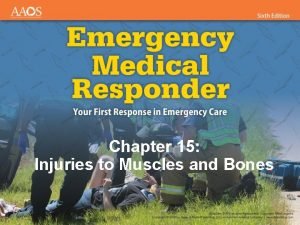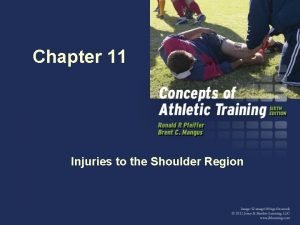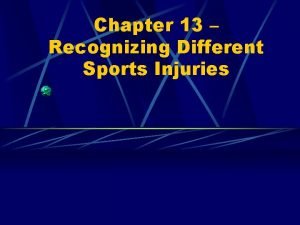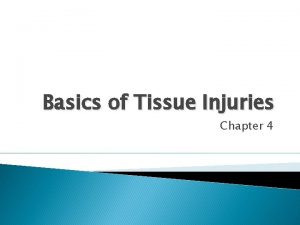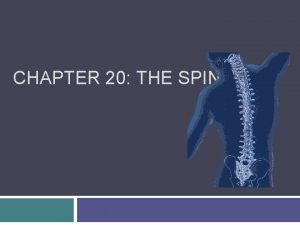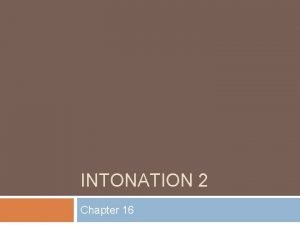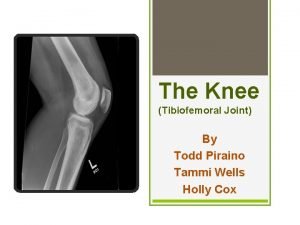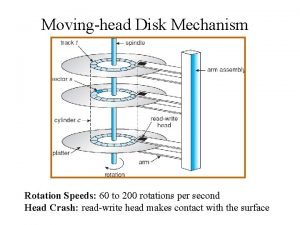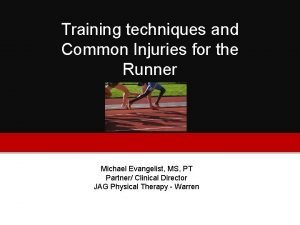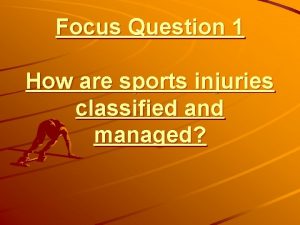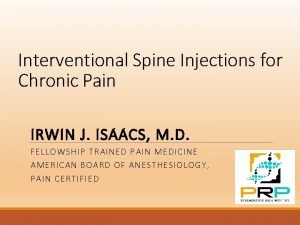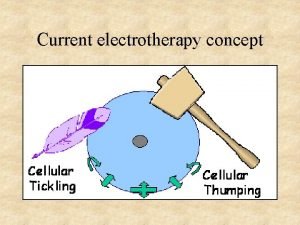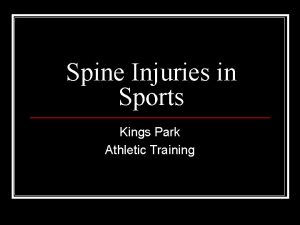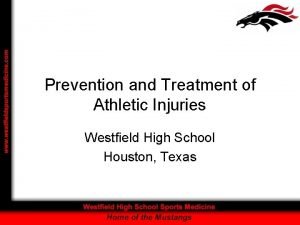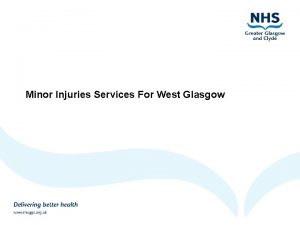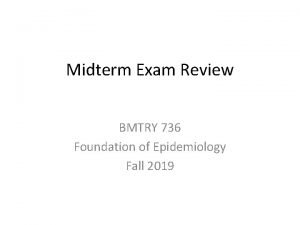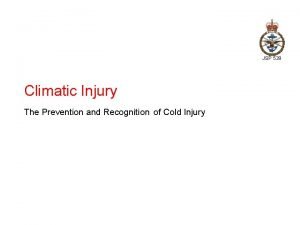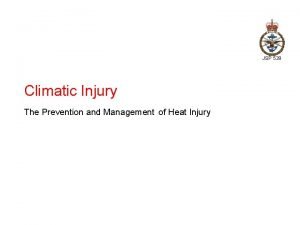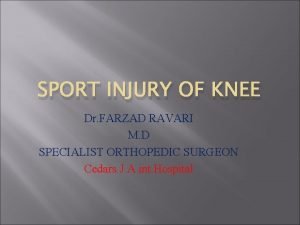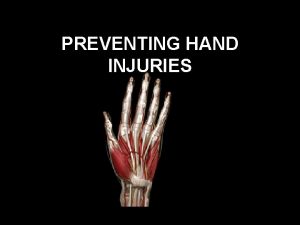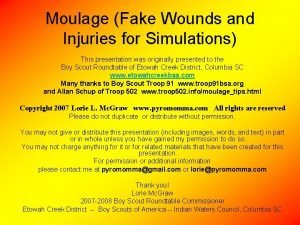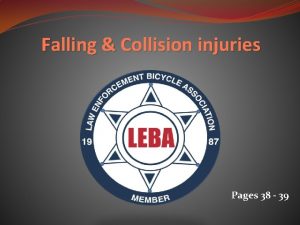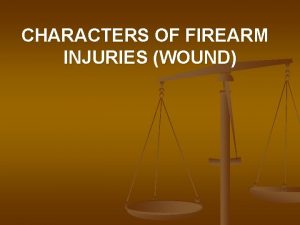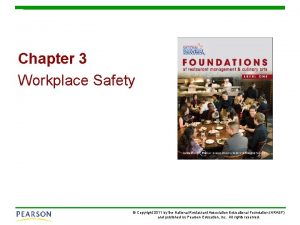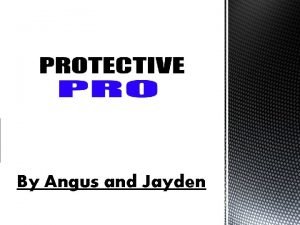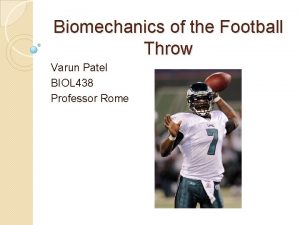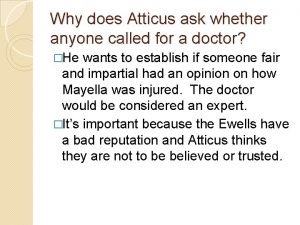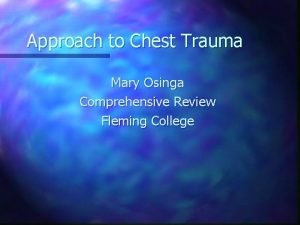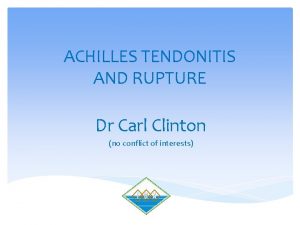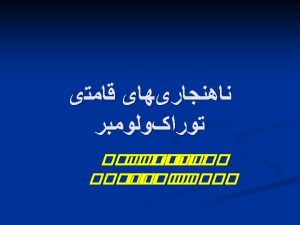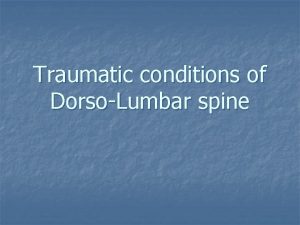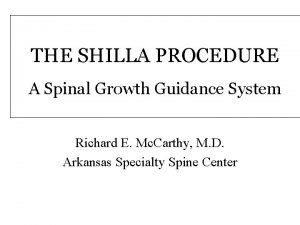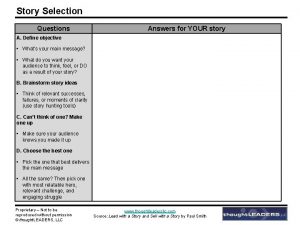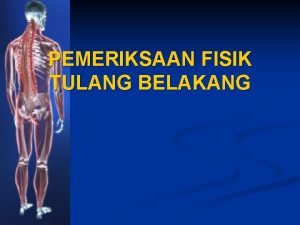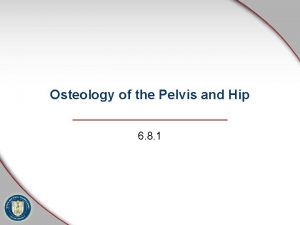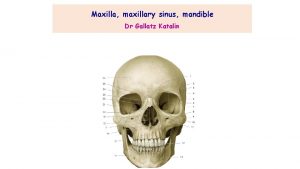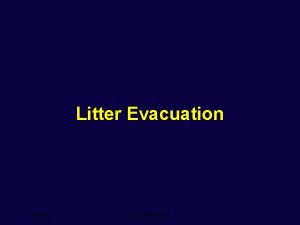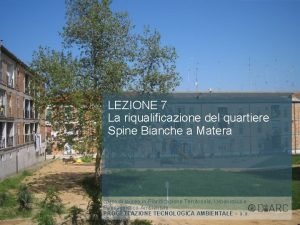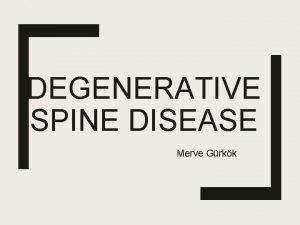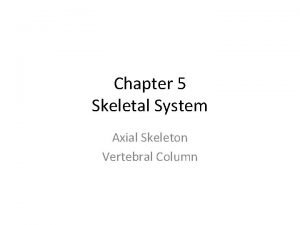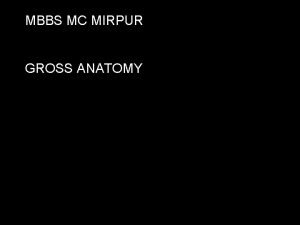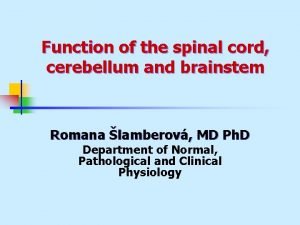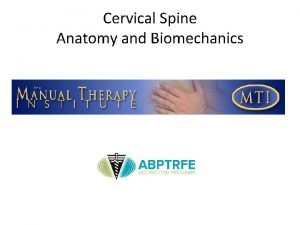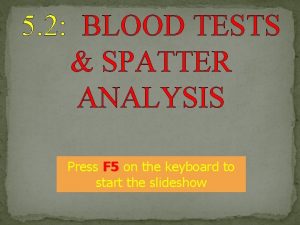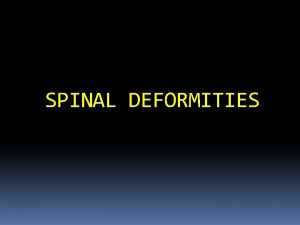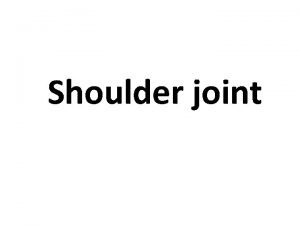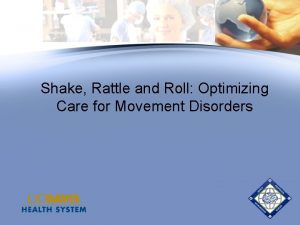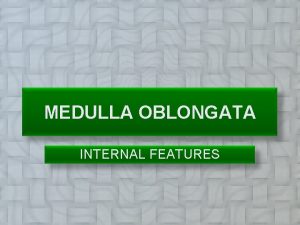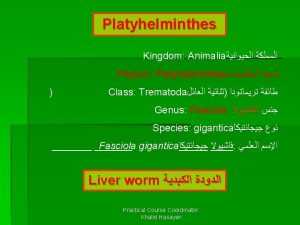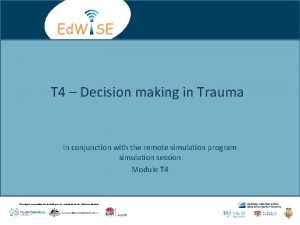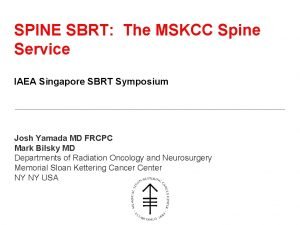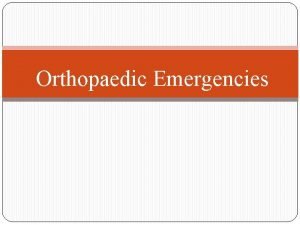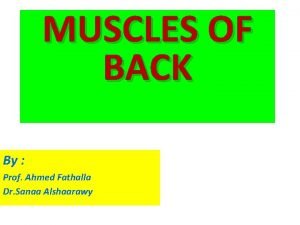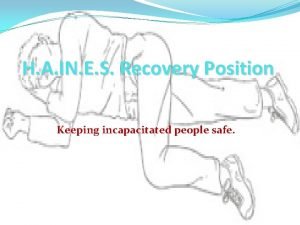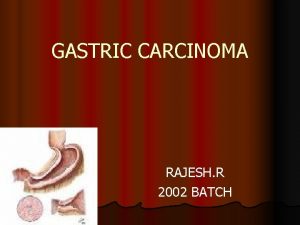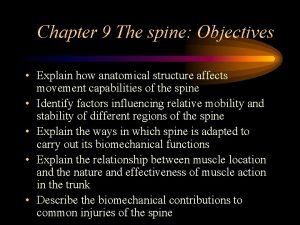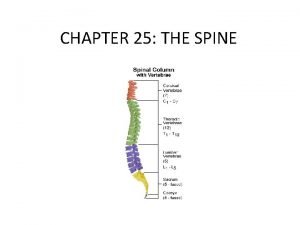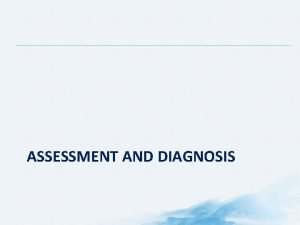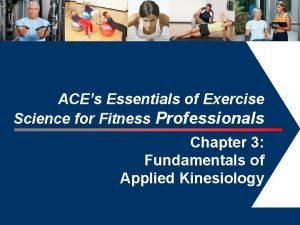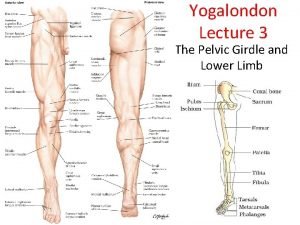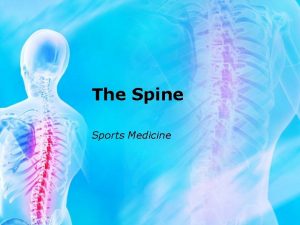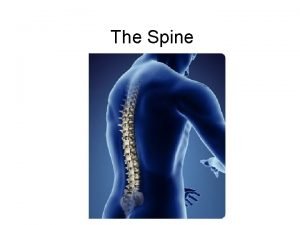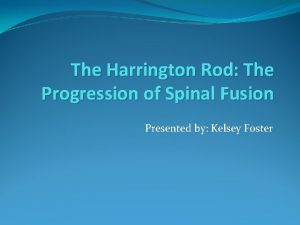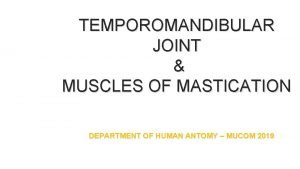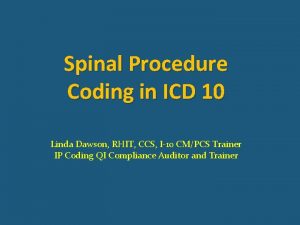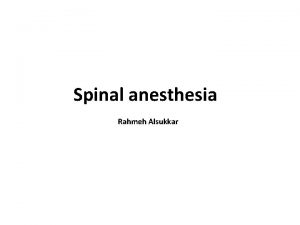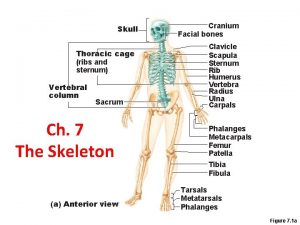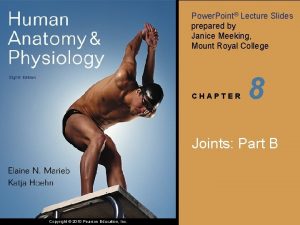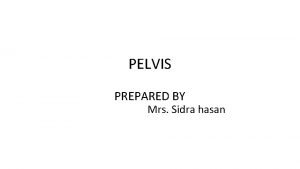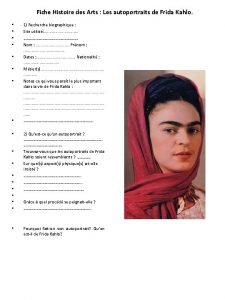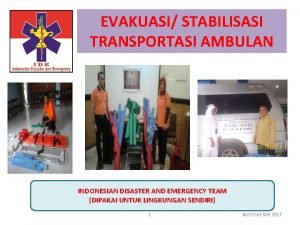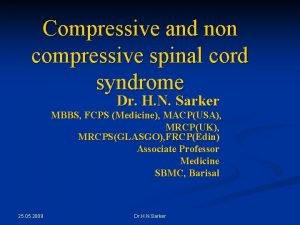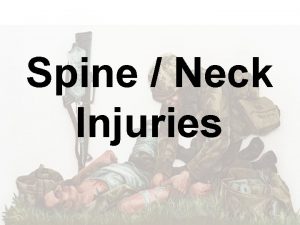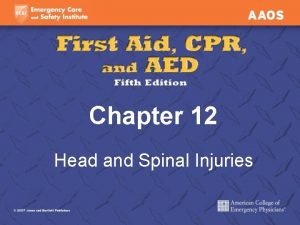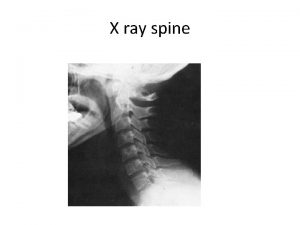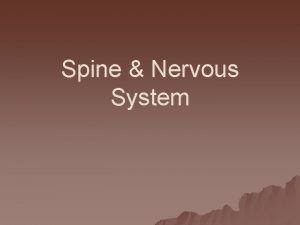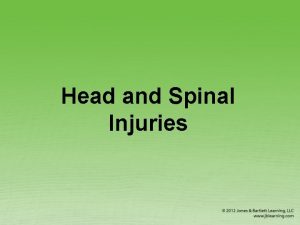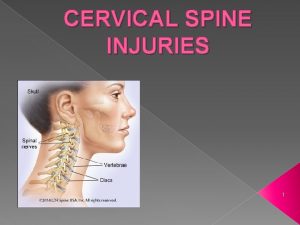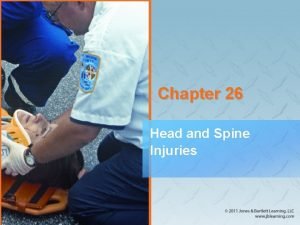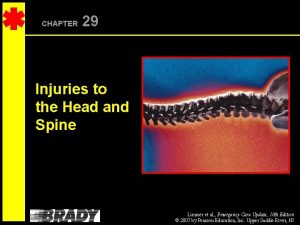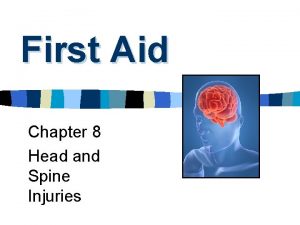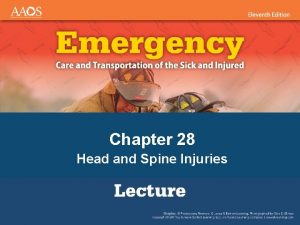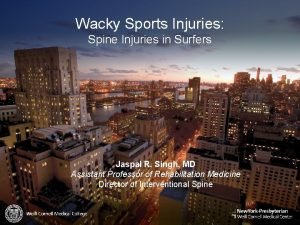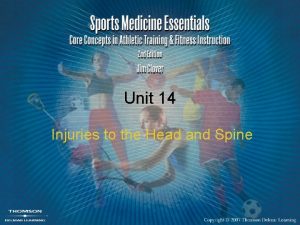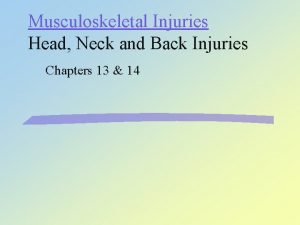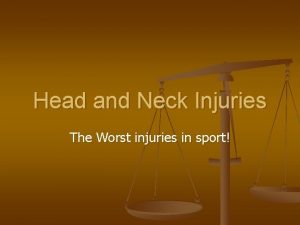Chapter 28 Head and Spine Injuries Introduction 1




































































































































- Slides: 132

Chapter 28 Head and Spine Injuries

Introduction (1 of 2) • The nervous system is a complex network of nerve cells that enables all parts of the body to function. • Includes: – Brain – Spinal cord – Several billion nerve fibers

Introduction (2 of 2) • The nervous system is well protected. – The brain is protected by the skull. – The spinal cord is protected by the spinal canal. • Despite this protection, serious injuries can damage the nervous system.

Anatomy and Physiology (1 of 2) • The nervous system is divided into two anatomic parts: – Central nervous system – Peripheral nervous system

Anatomy and Physiology (2 of 2) © Jones & Bartlett Learning.

Central Nervous System (1 of 7) • Includes the brain and spinal cord • The brain controls the body and is the center of consciousness. • Brain is divided into three major areas: – Cerebrum – Cerebellum – Brainstem

Central Nervous System (2 of 7) © Jones & Bartlett Learning.

Central Nervous System (3 of 7) • Cerebrum – Controls a wide variety of activities, including most voluntary motor function and conscious thought • Cerebellum – Coordinates balance and body movements • Brainstem – Controls most functions necessary for life

Central Nervous System (4 of 7) • Spinal cord – Made up of fibers that extend from the brain’s nerve cells – Carries messages between the brain and the body via the grey and white matter of the spinal cord

Central Nervous System (5 of 7) • Protective coverings – Brain and spinal cord are covered with thick, bony structures – The CNS is further protected by the meninges. • Outer layer (dura mater) is a tough, fibrous layer that forms a sac to contain the CNS • Inner two layers (arachnoid mater and pia mater) contain the blood vessels

Central Nervous System (6 of 7) © Jones & Bartlett Learning.

Central Nervous System (7 of 7) • Cerebrospinal fluid (CSF) – Produced in a chamber inside the brain called the third ventricle – Primarily acts as a shock absorber

Peripheral Nervous System (1 of 4) • 31 pairs of spinal nerves – Conduct impulses from the skin and other organs to the spinal cord – Conduct motor impulses from the spinal cord to the muscles • 12 pairs of cranial nerves – Transmit information directly to or from the brain

Peripheral Nervous System (2 of 4) © Jones & Bartlett Learning.

Peripheral Nervous System (3 of 4) • Two types of peripheral nerves – Sensory nerves • Carry only one type of information from the body to the brain via the spinal cord – Motor nerves • Carry information from the CNS to the muscles

Peripheral Nervous System (4 of 4) • Connecting nerves – Found only in the brain and spinal cord – Connect the sensory and motor nerves with short fibers – Allow the exchange of simple messages

How the Nervous System Works (1 of 3) • Controls virtually all the body’s activities, including: – Reflex activities – Voluntary activities (consciously performed) – Involuntary activities (not under conscious control)

How the Nervous System Works (2 of 3) • Connecting nerves in the spinal cord form a reflex arc. – If a sensory nerve detects an irritating stimulus, it bypasses the brain and sends the message directly to a motor nerve. © Jones & Bartlett Learning.

How the Nervous System Works (3 of 3) • Somatic (voluntary) nervous system handles voluntary activities • Autonomic (involuntary) nervous system handles body functions – Sympathetic nervous system reacts to stress with a fight-or-flight response. – Parasympathetic nervous system has the opposite effect on the body.

Skeletal System (1 of 4) • Skull – The skull is composed of the cranium, which protects the brain, and the facial bones. © Jones & Bartlett Learning. – Brain connects to the spinal cord

Skeletal System (2 of 4) • Skull (cont’d) – Four major bones make up the cranium: occiput, temples, parietal regions, and frontal region – Face is composed of 14 bones: maxilla, zygoma, mandible, nasal, and frontal bones

Skeletal System (3 of 4) • Spinal column – Body’s central supporting structure – 33 vertebrae are divided into five sections – Vertebrae are connected by ligaments and separated by cushions, called intervertebral disks – Spinal column is almost entirely surrounded by muscles

Skeletal System (4 of 4) © Jones & Bartlett Learning.

Head Injuries (1 of 4) • Traumatic insult to the head that may result in injury to soft tissue, bony structures, or the brain – Head injuries account for more than half of all traumatic deaths. – Fatal injuries invariably involve the brain. – Be alert to the fact that the patient may have sustained additional trauma.

Head Injuries (2 of 4) • Closed injuries – The brain has been injured but there is no opening into the brain. • Open injuries – Often caused by penetrating trauma – May be bleeding and exposed brain tissue

Head Injuries (3 of 4) • Motor vehicle crashes are the most common MOI. • Other common MOIs include assault, falls, and sports-related injuries.

Head Injuries (4 of 4) © Jones & Bartlett Learning.

Scalp Lacerations • Can be minor or serious • Small lacerations can lead to significant blood loss. – Especially in children

Skull Fracture (1 of 6) • May be open or closed, depending on whethere is an overlying laceration of the scalp • Signs of skull fracture include: – Patient’s head appears deformed – Visible cracks in the skull – Ecchymosis (bruising) under the eyes (raccoon eyes) or behind one ear over the mastoid process (Battle’s sign)

Skull Fracture (2 of 6) © E. M. Singletary, MD. Used with permission © Mediscan/Alamy.

Skull Fracture (3 of 6) • Linear skull fractures – Account for about 80% of all skull fractures © Jones & Bartlett Learning. – Radiographs are required to diagnose a linear skull fracture because there are often no physical signs.

Skull Fracture (4 of 6) • Depressed skull fractures – Result from highenergy direct trauma to the head by a blunt object – Bony fragments may be driven into the brain, resulting in injury © Jones & Bartlett Learning.

Skull Fracture (5 of 6) • Basilar skull fractures – Associated with highenergy trauma – Signs include CSF drainage from the ears, raccoon eyes, and Battle’s sign © Jones & Bartlett Learning.

Skull Fracture (6 of 6) • Open skull fractures – Often associated with trauma to multiple body systems – Brain tissue may be exposed to the environment. © Jones & Bartlett Learning.

Traumatic Brain Injuries (1 of 3) • Most serious of all head injuries • Two broad categories: primary (direct) injury and secondary (indirect) injury – Primary brain injury results instantaneously from impact to the head. – Secondary brain injury increases the severity of the primary injury.

Traumatic Brain Injuries (2 of 3) • Secondary injury may be caused by: – Hypoxia – Hypotension – Cerebral edema – Intracranial hemorrhage – Increased intracranial pressure – Cerebral ischemia – Infection

Traumatic Brain Injuries (3 of 3) • Can result from blunt or penetrating trauma • Coup-countercoup injury – Initial impact injures front part of brain – Head falling back against headrest injures rear part of brain • Cerebral edema (swelling of the brain) may not develop until several hours following the initial injury.

Intracranial Pressure (1 of 7) • Accumulation of blood within the skull or swelling of the brain can rapidly lead to an increase in ICP. – Increased ICP squeezes the brain against bony prominences within the cranium.

Intracranial Pressure (2 of 7) • Signs of increased intracranial pressure – Abnormal respiratory patterns – Decreased pulse rate, headache, nausea, vomiting, decreased alertness, bradycardia, sluggish or nonreactive pupils, decerebrate posturing, and increased or widened blood pressure – Cushing reflex

Intracranial Pressure (3 of 7) • Intracranial hemorrhage – Bleeding inside the skull also increases the ICP. – Bleeding can occur: • Between the skull and dura mater • Beneath the dura mater but outside the brain • Within the tissue of the brain itself

Intracranial Pressure (4 of 7) • Epidural hematoma – Accumulation of blood between the skull and dura mater © Jones & Bartlett Learning. – Nearly always the result of a blow to the head • Produced by a linear fracture of the thin temporal bone

Intracranial Pressure (5 of 7) • Subdural hematoma – Accumulation of blood beneath the dura mater but outside the brain © Jones & Bartlett Learning. – Occurs after falls or injuries involving strong deceleration forces

Intracranial Pressure (6 of 7) • Intracerebral hematoma – Bleeding within the brain tissue itself © Jones & Bartlett Learning. – Can occur following a penetrating injury to the head or because of rapid deceleration forces

Intracranial Pressure (7 of 7) • Subarachnoid hemorrhage – Bleeding occurs into the subarachnoid space, where the CSF circulates. – Results in bloody CSF and signs of meningeal irritation – Common causes include trauma or rupture of an aneurysm.

Concussion (1 of 2) • A blow to the head or face may cause concussion of the brain. – Considered a mild TBI – Temporary loss or alteration of part or all of the brain’s abilities to function without physical damage to the brain – About 90% of patients do not experience a loss of consciousness.

Concussion (2 of 2) • A patient may be confused or have amnesia. • Usually lasts only a short time • Assume that a patient with signs or symptoms of concussion has a more serious injury until proven otherwise.

Contusion • More serious than a concussion • Involves physical injury to brain tissue • May sustain long-lasting and even permanent damage • A patient may exhibit any or all of the signs of brain injury.

Other Brain Injuries • Brain injuries can also arise from medical conditions, such as blood clots or hemorrhages. • Signs and symptoms are often the same as those of traumatic brain injuries.

Spine Injuries (1 of 2) • Compression injuries can result from a fall. – Forces that compress the patient’s vertebral body can cause herniation of disks. • Motor vehicle crashes can overextend the spine. • Rotation-flexion injuries of the spine result from rapid acceleration forces.

Spine Injuries (2 of 2) • When the spine is pulled along its length (hyperextension), it can cause fractures • Any one of these unnatural motions can result in fractures or neurologic deficit. • When bones of the spine are altered from traumatic forces, they can fracture or move out of place.

Patient Assessment (1 of 2) • Always suspect a possible head or spinal injury with: – Motor vehicle collisions – Pedestrian–motor vehicle collisions – Falls – Blunt trauma – Penetrating trauma to the head, neck, back, or torso

Patient Assessment (2 of 2) • Always suspect a possible head or spinal injury with (cont’d): – Rapid deceleration injuries – Hangings – Axial loading injuries – Diving accidents

Scene Size-Up • Scene safety – Evaluate every scene for hazards to your health and the health of your team or bystanders. – Use standard precautions. • Mechanism of injury/nature of illness – Look for indicators of the MOI. – Consider how the MOI produced the injuries expected.

Primary Assessment (1 of 8) • Focus on identifying and managing lifethreatening concerns. • Reduction of on-scene time and recognition of a critical patient increase the patient’s chances for survival or a reduction in the amount of irreversible damage.

Primary Assessment (2 of 8) • Spinal immobilization considerations – Assess the patient in the position found. – Assess the scene to determine the risk of injury. • Backboard often places the patient in an anatomically incorrect position for a long period of time

Primary Assessment (3 of 8) • Cervical collar – Once the cervical collar is on, do not remove it unless it causes a problem with maintaining the airway. – If you must remove the device, maintain manual stabilization of the cervical spine until it can be replaced.

Primary Assessment (4 of 8) • Assessing for signs and symptoms of a head or spine injury – Ask about the chief complaint. – Confused or slurred speech, repetitive questioning, or amnesia in responsive patients are indications of a head injury. – In the setting of trauma, assume your patient has a head injury until your assessment proves otherwise.

Primary Assessment (5 of 8) • Assessing for signs and symptoms of a head or spine injury (cont’d) – Unresponsive trauma patients should be assumed to have a spinal injury. – Patients with a decreased level of responsiveness should be considered to have a spinal injury based on their chief complaint.

Primary Assessment (6 of 8) • Airway, breathing, and circulation considerations – Use a jaw-thrust maneuver to open the airway. – Vomiting may occur. – Irregular breathing may result from increased pressure on the brain. – Oxygen is always indicated for patients with head and spinal injuries.

Primary Assessment (7 of 8) • Airway, breathing, and circulation considerations (cont’d) – A pulse that is too slow can indicate a serious condition. – A single episode of hypoperfusion can lead to significant brain damage and even death. – Assess for signs and symptoms of shock. – Control bleeding.

Primary Assessment (8 of 8) • Manner of transport – Patients with impaired airways, open head wounds, or abnormal vital signs may need to be rapidly extracted from a motor vehicle and transported. – Lights and sirens can lead to patient anxiety.

History Taking • Investigate the chief complaint. – Obtain a medical history and be alert for injuryspecific signs and symptoms as well as pertinent negatives. – If the patient is not responsive, attempt to obtain the history from other sources.

Secondary Assessment (1 of 6) • Instruct the patient to keep still and not to move the head or neck. • Physical examinations – May be a systematic head-to-toe, full-body scan or a systematic assessment that focuses on a certain area or region of the body

Secondary Assessment (2 of 6) • Physical examinations (cont’d) – Obtaining a complete set of baseline vital signs is essential. – Use monitoring devices. – Perform a full-body scan using DCAP-BTLS and examine the head, chest, abdomen, extremities, and back. – Check perfusion, motor function, and sensation in all extremities prior to moving the patient.

Secondary Assessment (3 of 6) • Physical examinations (cont’d) – A decreased level of consciousness is the most reliable sign of a head injury. – Look for leaking blood or CSF. – Assess pupil size and reaction to light and continue to monitor the pupils.

Secondary Assessment (4 of 6) • Neurologic examination – Perform baseline assessment using the Glasgow Coma Scale (GCS). – Record levels of consciousness that fluctuate or deteriorate.

Secondary Assessment (5 of 6) © Jones & Bartlett Learning.

Secondary Assessment (6 of 6) • Spine examination – Inspect for DCAP-BTLS and check the extremities for circulation, motor, or sensory problems. – Pain or tenderness is a warning sign. – Other signs and symptoms include deformity; numbness, weakness, or tingling in the extremities; and soft-tissue injuries in the spinal region.

Reassessment (1 of 3) • Repeat the primary assessment. • Reassess vital signs and the chief complaint. • Recheck patient interventions.

Reassessment (2 of 3) • Interventions – These injuries can suddenly affect the respiratory, circulatory, and nervous systems. – Reassess at least every 5 minutes. – Compare baseline vital signs with repeated vital signs. – You will notice deterioration in a conscious patient’s awareness of time, place, and person (self), in that order.

Reassessment (3 of 3) • Communication and documentation – Provide complete and detailed information to the destination facility. – Document vital signs for unstable patients every 5 minutes, every 15 minutes for stable patients.

Emergency Medical Care of Head Injuries (1 of 5) • Three general principles: – Establish an adequate airway. – Control bleeding and provide adequate circulation to maintain cerebral perfusion. – Assess and continuously monitor the patient’s level of consciousness

Emergency Medical Care of Head Injuries (2 of 5) • Managing the airway – Once the airway is open, maintain the head and cervical spine in a neutral, in-line position until you have placed a cervical collar and have secured the patient on a backboard. – Remove any foreign bodies, secretions, or vomitus. – Give supplemental oxygen to any patient with suspected head injury.

Emergency Medical Care of Head Injuries (3 of 5) © Jones & Bartlett Learning. Photo by Darren Stahlman.

Emergency Medical Care of Head Injuries (4 of 5) • Circulation – Begin CPR if the patient is in cardiac arrest. – Control bleeding from a scalp laceration by applying direct pressure over the wound. • Shock is usually the result of hypovolemia. – Transport immediately

Emergency Medical Care of Head Injuries (5 of 5) • Cushing’s triad – Increased blood pressure (hypertension) – Decreased heart rate (bradycardia) – Irregular respirations (Cheyne-Stokes respirations or Biot respirations) – Perform controlled hyperventilation of your patient via positive-pressure ventilations at a rate of 20 breaths/min.

Emergency Medical Care of Spinal Injuries (1 of 4) • Follow standard precautions. • Maintain the patient’s airway while keeping the spine in the proper position. • Manage the airway

Emergency Medical Care of Spinal Injuries (2 of 4) • Immobilization of the cervical spine – Immobilize the head and trunk so that bone fragments do not cause further damage. – Never force the head into a neutral, in-line position. – Stabilize the patient in his or her current position.

Emergency Medical Care of Spinal Injuries (3 of 4) © Jones & Bartlett Learning. Courtesy of MIEMSS.

Emergency Medical Care of Spinal Injuries (4 of 4) • Cervical collars © Jones & Bartlett Learning. – Provide preliminary, partial support – Should be applied to every patient who has a possible spinal injury – To be effective, a rigid cervical collar must be the correct size

Preparation for Transport (1 of 7) • Supine patients – Secure to a long backboard or vacuum mattress. – Another procedure to move a patient from the ground to a backboard is the four-person log roll. – You may also slide the patient onto a backboard or vacuum mattress.

Preparation for Transport (2 of 7) • Vacuum mattress – – An alternative to the long backboard Molds to the specific contours of patient’s body Provides thermal insulation Excellent for the elderly or a patient with abnormal curvature of the spine – Can be used on a supine, sitting, or standing patient

Preparation for Transport (3 of 7) • Sitting patients – Use a short backboard to restrict movement of the cervical and thoracic spine. – Then secure the short board to the long board. – Exceptions include situations in which: • You or the patient is in danger • You need immediate access to other patients • The patient’s injuries justify urgent removal

Preparation for Transport (4 of 7) • Standing patients – Immobilize the patient to a long backboard before proceeding with assessment. – Establish manual, in-line stabilization and apply a cervical collar. – Position the board upright directly behind the patient. – Carefully lower the patient as a unit under the direction of the EMT at the head.

Preparation for Transport (5 of 7) • Spinal immobilization devices – Assume the presence of spinal injury in all patients who have sustained head injuries – Use manual in-line stabilization or a cervical collar and long backboard

Preparation for Transport (6 of 7) • Short backboards © Kendrick EMS – Vest-type device and rigid short board – Designed to immobilize and restrict movement of the head, neck, and torso – Used to immobilize noncritical patients found in a sitting position

Preparation for Transport (7 of 7) • Long backboards – Provide full body spinal immobilization and motion restriction to the head, neck, torso, pelvis, and extremities – Used to immobilize patients found in any position © luoman/i. Stock/Getty.

Helmet Removal (1 of 5) • A helmet that fits well prevents the patient’s head from moving and should be left on, provided: – There are no impending airway or breathing problems. – It does not interfere with assessment and treatment of airway or ventilation problems. – You can properly immobilize the spine.

Helmet Removal (2 of 5) • Remove a helmet if: – It is a full-face helmet. – It makes assessing or managing airway problems difficult. – It prevents you from properly immobilizing the spine. – It allows excessive head movement. – The patient is in cardiac arrest.

Helmet Removal (3 of 5) • Preferred method – Removing a helmet should always be at least a two-person job. – You should first consult with medical control about your decision to remove a helmet.

Helmet Removal (4 of 5) • Alternate method – The advantage is that it allows the helmet to be removed with the application of less force, therefore reducing the likelihood of motion occurring in the neck. – The disadvantage is that it is slightly more time consuming.

Helmet Removal (5 of 5) • Alternate method (cont’d) – Remove the chin strap. – Remove the face mask. – Pop the jaw pads out of place. – Place your fingers inside the helmet. – Hold the jaw with one hand the occiput with the other. – Insert padding behind the occiput.

Review 1. The brain, a part of the central nervous system (CNS), is divided into the: A. cerebrum, cerebellum, and brain stem. B. cerebrum, brain stem, and spinal cord. C. cerebellum, cerebrum, and spinal cord. D. spinal cord, cerebrum, and cerebral cortex.

Review Answer: A Rationale: The brain and spinal cord comprise the central nervous system (CNS). The brain is divided into three major regions: the cerebrum (the largest portion), the cerebellum, and the brain stem. Each region of the brain carries out specific functions.

Review (1 of 2) 1. The brain, a part of the central nervous system (CNS), is divided into the: A. cerebrum, cerebellum, and brain stem. Rationale: Correct answer B. cerebrum, brain stem, and spinal cord. Rationale: The spinal cord is not part of the brain.

Review (2 of 2) 1. The brain, a part of the central nervous system (CNS), is divided into the: C. cerebellum, cerebrum, and spinal cord. Rationale: The spinal cord is not part of the brain. D. spinal cord, cerebrum, and cerebral cortex. Rationale: The spinal cord is not part of the brain.

Review 2. As you are assessing a 24 -year-old man with a large laceration to the top of his head, you should recall that: A. the scalp, unlike other parts of the body, has relatively fewer blood vessels. B. blood loss from a scalp laceration may contribute to hypovolemic shock in adults. C. any avulsed portions of the scalp should be carefully cut away to facilitate bandaging. D. most scalp injuries are superficial and are rarely associated with more serious injuries.

Review Answer: B Rationale: Although the scalp is highly vascular and tends to bleed heavily when injured, scalp injuries are rarely the sole cause of hypovolemic shock in adults. However, they can contribute to hypovolemia caused by injuries elsewhere in the body. Scalp lacerations, whether deep or superficial, should prompt you to look for more serious underlying injuries, such as a skull fracture. If the injury involves an avulsion, the avulsed flap of skin should be carefully replaced to its original position, not cut away.

Review (1 of 2) 2. As you are assessing a 24 -year-old man with a large laceration to the top of his head, you should recall that: A. the scalp, unlike other parts of the body, has relatively fewer blood vessels. Rationale: The scalp is highly vascular. B. blood loss from a scalp laceration may contribute to hypovolemic shock in adults. Rationale: Correct answer

Review (2 of 2) 2. As you are assessing a 24 -year-old man with a large laceration to the top of his head, you should recall that: C. any avulsed portions of the scalp should be carefully cut away to facilitate bandaging. Rationale: The avulsed flap should be carefully replaced to its original position. D. most scalp injuries are superficial and are rarely associated with more serious injuries. Rationale: Deep or superficial scalp lacerations should prompt EMS providers to assess for more serious underlying injuries.

Review 3. A patient who experiences an immediate loss of consciousness followed by a lucid interval has a(n): A. epidural hematoma. B. subdural hematoma. C. concussion. D. contusion.

Review Answer: A Rationale: Epidural hematomas are caused by injury to an artery—usually the middle meningeal artery—that lies in between the skull and brain. Patients with an epidural hematoma typically experience an immediate loss of consciousness, followed by a brief period of consciousness (lucid interval), as intracranial pressure increases. Subdural hematomas are the result of injury to a vein; therefore, they tend to bleed slowly and usually cause a progressive decline in level of consciousness. Concussions and contusions may cause a loss of consciousness, but it is typically brief.

Review (1 of 2) 3. A patient who experiences an immediate loss of consciousness followed by a lucid interval has a(n): A. epidural hematoma. Rationale: Correct answer B. subdural hematoma. Rationale: Subdural hematomas tend to bleed slowly and usually cause a progressive decline in the level of consciousness.

Review (2 of 2) 3. A patient who experiences an immediate loss of consciousness followed by a lucid interval has a(n): C. concussion. Rationale: Concussions may cause a loss of consciousness, but is typically brief. D. contusion. Rationale: Contusions may cause a loss of consciousness, but is typically brief.

Review 4. A 44 -year-old man was struck in the back of the head and was reportedly unconscious for approximately 30 seconds. He complains of a severe headache and “seeing stars, ” and states that he regained his memory shortly before your arrival. His presentation is MOST consistent with a(n): A. contusion. B. concussion. C. subdural hematoma. D. intracerebral hemorrhage.

Review Answer: B Rationale: A concussion occurs when the brain is jarred around inside the skull. It may result in a brief loss of consciousness and, occasionally, amnesia. Seeing stars is a common finding following trauma to the back of the head (occiput), as this region is primarily responsible for vision. A concussion—the least severe of all closed head injuries—typically does not result in physical damage to the brain. Compared to a concussion, a contusion, subdural hematoma, and intracerebral hemorrhage are usually associated with a more prolonged loss of consciousness.

Review (1 of 2) 4. A 44 -year-old man was struck in the back of the head and was reportedly unconscious for approximately 30 seconds. He complains of a severe headache and “seeing stars, ” and states that he regained his memory shortly before your arrival. His presentation is MOST consistent with a(n): A. contusion. Rationale: This is when brain tissue is damaged and the patient presents with prolonged confusion and loss of consciousness. B. concussion. Rationale: Correct answer

Review (2 of 2) 4. A 44 -year-old man was struck in the back of the head and was reportedly unconscious for approximately 30 seconds. He complains of a severe headache and “seeing stars, ” and states that he regained his memory shortly before your arrival. His presentation is MOST consistent with a(n): C. subdural hematoma. Rationale: This is an accumulation of blood beneath the dura mater. D. intracerebral hemorrhage. Rationale: This is bleeding within the brain itself.

Review 5. A young male was involved in a motor vehicle accident and experienced a closed head injury. He has no memory of the events leading up to the accident, but remembers that he was going to a birthday party. What is the correct term to use when documenting his memory loss? A. Concussion B. Cerebral contusion C. Retrograde amnesia D. Anterograde amnesia

Review Answer: C Rationale: The term amnesia means loss of memory; it is common in patients who have experienced a cerebral concussion. Amnesia of events leading up to an injury is called retrograde amnesia. Anterograde amnesia— also called posttraumatic amnesia—is the inability to remember events that occurred—or will occur—after the injury.

Review (1 of 2) 5. A young male was involved in a motor-vehicle accident and experienced a closed head injury. He has no memory of the events leading up to the accident, but remembers that he was going to a birthday party. What is the correct term to use when documenting his memory loss? A. Concussion Rationale: This occurs when the brain is jarred inside the skull. B. Cerebral contusion Rationale: This is when tissue is bruised and damaged in a local area. It may result in prolonged confusion.

Review (2 of 2) 5. A young male was involved in a motor-vehicle accident and experienced a closed head injury. He has no memory of the events leading up to the accident, but remembers that he was going to a birthday party. What is the correct term to use when documenting his memory loss? C. Retrograde amnesia Rationale: Correct answer D. Anterograde amnesia Rationale: This is the loss of memory relating to events that occurred after the injury.

Review 6. A distraction injury to the cervical spine would MOST likely occur following: A. a diving accident. B. blunt neck trauma. C. hyperextension of the neck. D. hanging-type mechanisms.

Review Answer: D Rationale: Excessive traction on the neck, such as what occurs during hanging-type mechanisms, can cause a distraction injury of the cervical spine. Distraction injuries can cause separation of the vertebrae and stretching or tearing of the spinal cord.

Review (1 of 2) 6. A distraction injury to the cervical spine would MOST likely occur following: A. a diving accident. Rationale: This would possibly cause a compression injury. B. blunt neck trauma. Rationale: This can result in a fracture or neurologic deficit.

Review (2 of 2) 6. A distraction injury to the cervical spine would MOST likely occur following: C. hyperextension of the neck. Rationale: This can result in a fracture or neurologic deficit. D. hanging-type mechanisms. Rationale: Correct answer

Review 7. During immobilization of a patient with a possible spinal injury, manual stabilization of the head must be maintained until: A. an appropriate-size extrication collar has been placed. B. the patient is fully immobilized on a long backboard. C. a range of motion test of the neck has been completed. D. pulse, motor, and sensory functions are found to be intact.

Review Answer: B Rationale: Manual stabilization of the patient’s head must be maintained until he or she is fully secured to the long backboard. This includes the application of an extrication collar, straps, and lateral immobilization (head blocks). Pulse, motor, and sensory functions must be checked before and after the immobilization process. Do not assess range of motion in a patient with a possible spinal injury; this involves moving the patient’s neck and may cause further injury.

Review (1 of 2) 7. During immobilization of a patient with a possible spinal injury, manual stabilization of the head must be maintained until: A. an appropriate-size extrication collar has been placed. Rationale: This is only one small part of the total immobilization process. B. the patient is fully immobilized on a long backboard. Rationale: Correct answer

Review (2 of 2) 7. During immobilization of a patient with a possible spinal injury, manual stabilization of the head must be maintained until: C. a range of motion test of the neck has been completed. Rationale: Do not assess the range of motion in a patient with a possible spinal injury. D. pulse, motor, and sensory functions are found to be intact. Rationale: This is done before and after complete immobilization.

Review 8. Your patient is a 21 -year-old male who has massive face and head trauma after being assaulted. He is lying supine, is semiconscious, and has blood in his mouth. You should: A. insert a nasal airway, assess his respirations, and give 100% oxygen. B. suction his airway and apply high-flow oxygen via a nonrebreathing mask. C. manually stabilize his head, log roll him onto his side, and suction his mouth. D. apply a cervical collar, suction his airway, and begin assisting his ventilations.

Review Answer: C Rationale: Blood or other secretions in the mouth place the airway in immediate jeopardy and must be removed before they are aspirated. At the same time, you must protect the patient’s spine due the mechanism of injury. Therefore, you should manually stabilize the patient’s head, log roll him onto his side (allows drainage of blood from his mouth), and suction his mouth for up to 15 seconds. After ensuring that his airway is clear, assess his breathing and give high-flow oxygen or assist his ventilations. Nasal airways should not be used in patients with severe facial or head trauma.

Review (1 of 2) 8. Your patient is a 21 -year-old male who has massive face and head trauma after being assaulted. He is lying supine, is semiconscious, and has blood in his mouth. You should: A. insert a nasal airway, assess his respirations, and give 100% oxygen. Rationale: Nasal airways should not be used in patients with severe facial or head trauma or with suspected fractures. B. suction his airway and apply high-flow oxygen via a nonrebreathing mask. Rationale: This must be done after manual stabilization of the spine and rolling the patient to his side.

Review (2 of 2) 8. Your patient is a 21 -year-old male who has massive face and head trauma after being assaulted. He is lying supine, is semiconscious, and has blood in his mouth. You should: C. manually stabilize his head, log roll him onto his side, and suction his mouth. Rationale: Correct answer D. apply a cervical collar, suction his airway, and begin assisting his ventilations. Rationale: The cervical collar should be applied, but manual stabilization must take place first. There are no indications here that the patient’s rate of respirations are inadequate and require assisted ventilations.

Review 9. A man is found slumped over the steering wheel, unconscious and making snoring sounds, after an automobile accident. His head is turned to the side and his neck is flexed. You should: A. gently rotate his head to correct the deformity. B. carefully hyperextend his neck to open his airway. C. apply an extrication collar with his head in the position found. D. manually stabilize his head and move it to a neutral, in-line position.

Review Answer: D Rationale: The patient’s snoring sounds indicate an airway problem, which must be corrected or he may die. Manually stabilize his head; carefully move it to a neutral, in-line position; and reassess his breathing. Do not rotate or hyperextend the neck of a patient with a possible spinal injury; the results could be disastrous.

Review (1 of 2) 9. A man is found slumped over the steering wheel, unconscious and making snoring sounds, after an automobile accident. His head is turned to the side and his neck is flexed. You should: A. gently rotate his head to correct the deformity. Rationale: Do not hyperextend the neck of a patient with a possible spinal injury. B. carefully hyperextend his neck to open his airway. Rationale: Do not hyperextend the neck of a patient with a possible spinal injury.

Review (2 of 2) 9. A man is found slumped over the steering wheel, unconscious and making snoring sounds, after an automobile accident. His head is turned to the side and his neck is flexed. You should: C. apply an extrication collar with his head in the position found. Rationale: The head must be placed in a neutral position to open the airway. D. manually stabilize his head and move it to a neutral, in-line position. Rationale: Correct answer

Review 10. You should NOT remove an injured football player’s helmet if: A. a cervical spine injury is suspected, even if the helmet fits loosely. B. the patient has a patent airway, even if he has breathing difficulty. C. he has broken teeth, but only if the helmet does not fit snugly in place. D. the face guard can easily be removed and there is no airway compromise.

Review Answer: D Rationale: In general, you should leave a helmet on if it fits snugly and does not allow movement of the head within the helmet, the patient’s airway is patent, no airway problems are anticipated, and the patient is breathing without difficulty. If you can easily remove the face guard (often the case with football helmets) and there are no airway problems, do so but leave the helmet on. If the helmet is loose, the airway is in anyway compromised, or the patient has difficulty breathing or is in cardiac arrest, the helmet must be removed.

Review (1 of 2) 10. You should NOT remove an injured football player’s helmet if: A. a cervical spine injury is suspected, even if the helmet fits loosely. Rationale: If the helmet allows for movement of the head, it should be removed. B. the patient has a patent airway, even if he has breathing difficulty. Rationale: The helmet must be removed if the patient is having breathing difficulty.

Review (2 of 2) 10. You should NOT remove an injured football player’s helmet if: C. he has broken teeth, but only if the helmet does not fit snugly in place. Rationale: Broken teeth present a potential for airway obstruction. D. the face guard can easily be removed and there is no airway compromise. Rationale: Correct answer
 Chapter 28 head and spine injuries
Chapter 28 head and spine injuries Chapter 21 caring for head and spine injuries
Chapter 21 caring for head and spine injuries Emr chapter 15 injuries to muscles and bones
Emr chapter 15 injuries to muscles and bones Chapter 14:2 preventing accidents and injuries
Chapter 14:2 preventing accidents and injuries Jones and bartlett learning
Jones and bartlett learning Chapter 13:2 preventing accidents and injuries
Chapter 13:2 preventing accidents and injuries Chapter 11 assessment and evaluation of sports injuries
Chapter 11 assessment and evaluation of sports injuries Chapter 12 lesson 1 benefits of physical activity
Chapter 12 lesson 1 benefits of physical activity Chapter 17 1 providing first aid
Chapter 17 1 providing first aid Chapter 11 injuries to the shoulder region
Chapter 11 injuries to the shoulder region Chapter 4 preventing injuries through fitness
Chapter 4 preventing injuries through fitness Chapter 13 worksheet recognizing different sports injuries
Chapter 13 worksheet recognizing different sports injuries Chapter 4 basics of tissue injuries
Chapter 4 basics of tissue injuries Dividing head calculation formula
Dividing head calculation formula Positive suction head and negative suction head
Positive suction head and negative suction head Chapter 20 worksheet the spine
Chapter 20 worksheet the spine Chapter 25 worksheet the spine
Chapter 25 worksheet the spine The attacking firm goes head-to-head with its competitor.
The attacking firm goes head-to-head with its competitor. Html teksta noformēšana
Html teksta noformēšana Moving head disk mechanism in os
Moving head disk mechanism in os Parts of the neck
Parts of the neck What is a stressed syllable
What is a stressed syllable Quad innervation
Quad innervation Pre-head head tonic syllable tail
Pre-head head tonic syllable tail The head of moving head disk with 100 tracks
The head of moving head disk with 100 tracks Unit 15:8 providing first aid for cold exposure
Unit 15:8 providing first aid for cold exposure Common track and field injuries
Common track and field injuries How are sports injuries classified and managed
How are sports injuries classified and managed Cervical facet referral patterns
Cervical facet referral patterns Harborside spine and sports
Harborside spine and sports Who is in charge when spine boarding an athlete and why
Who is in charge when spine boarding an athlete and why Strickler spine and sport
Strickler spine and sport Beck weathers helicopter rescue
Beck weathers helicopter rescue Describe peeta's injuries
Describe peeta's injuries Westfield sports injuries
Westfield sports injuries Minor injuries unit stobhill
Minor injuries unit stobhill Human crutch carry
Human crutch carry Kristen wilson injuries
Kristen wilson injuries Uc davis web scheduler
Uc davis web scheduler The cause-specific mortality rate from roller-skating was:
The cause-specific mortality rate from roller-skating was: Climatic injuries
Climatic injuries Jsp 539
Jsp 539 Bo taoshi injuries
Bo taoshi injuries Torn lateral miniscus
Torn lateral miniscus Preventing hand injuries
Preventing hand injuries Examples of intentional injury
Examples of intentional injury How to make fake scars with vaseline
How to make fake scars with vaseline Intentional fallacy examples
Intentional fallacy examples Injury prevention safety and first aid
Injury prevention safety and first aid Injuries first aid
Injuries first aid Injuries first aid
Injuries first aid Characters of firearm injuries
Characters of firearm injuries Which osha document summarizes occupational injuries
Which osha document summarizes occupational injuries Sports injuries angus, on
Sports injuries angus, on Biomechanics of throwing a football
Biomechanics of throwing a football Who do dill and scout meet outside?
Who do dill and scout meet outside? Why have the gamemakers sent the thunderstorm?
Why have the gamemakers sent the thunderstorm? Chop saw injuries
Chop saw injuries Deadly dozen itls
Deadly dozen itls Clinton tendonitis
Clinton tendonitis Flat thoracic spine
Flat thoracic spine Dorsolumbar
Dorsolumbar Shilla growth guidance system
Shilla growth guidance system Rvad angle
Rvad angle Ruffini corpuscle
Ruffini corpuscle Incissive
Incissive The story spine
The story spine The story spine
The story spine Splanchnocranium viscerocranium
Splanchnocranium viscerocranium Spine technologies india pvt ltd
Spine technologies india pvt ltd Hip er rom
Hip er rom Reflek patela
Reflek patela Iliac tubercle
Iliac tubercle Distance decay example ap human geography
Distance decay example ap human geography Ring binder spine template
Ring binder spine template Alveolar process of mandible
Alveolar process of mandible Linear danger area hand signal
Linear danger area hand signal Quartiere spine bianche matera
Quartiere spine bianche matera Spine vs thorn
Spine vs thorn Extreme fabric automation
Extreme fabric automation Spine precautions
Spine precautions Spinal cord extends from
Spinal cord extends from 7 12 5 spine
7 12 5 spine Psis level with s2
Psis level with s2 Jenis-jenis layout toko
Jenis-jenis layout toko Spinal cord dorsal and ventral roots
Spinal cord dorsal and ventral roots Unitn merchandising
Unitn merchandising Reflexology lower back
Reflexology lower back Proximal tibia
Proximal tibia Function of medulla
Function of medulla Spine arthrokinematics
Spine arthrokinematics Median sacral crest
Median sacral crest Spine blood spatter definition
Spine blood spatter definition Spine allignment
Spine allignment Glenohumeral joint articulating bones
Glenohumeral joint articulating bones Rattle spine nms
Rattle spine nms Spine pathology
Spine pathology Spine
Spine Figure 13-2 spinal nerves labeled
Figure 13-2 spinal nerves labeled Spine meninges
Spine meninges Spine
Spine Embryophore
Embryophore Emory spine center
Emory spine center Mdcalc nexus c spine
Mdcalc nexus c spine Noms score spine
Noms score spine Nerve regions of the body
Nerve regions of the body Nexus rules c spine
Nexus rules c spine Lat dorsi innervation
Lat dorsi innervation Muscles of thoracic spine
Muscles of thoracic spine Latin american city model history
Latin american city model history H.a.in.e.s
H.a.in.e.s Pyloric adenoma
Pyloric adenoma Clinical biomechanics of the spine
Clinical biomechanics of the spine Thoracic vertebrae not labeled
Thoracic vertebrae not labeled Canadian c spine rules
Canadian c spine rules Trunk extensors
Trunk extensors Inferior ramus of pubis
Inferior ramus of pubis Split traction table
Split traction table Boney spine
Boney spine Spine components
Spine components Harrington rod
Harrington rod Genial tubercle
Genial tubercle True vertebrae
True vertebrae Foraminal encroachment icd 10
Foraminal encroachment icd 10 Paramedian epidural layers
Paramedian epidural layers Rib head articulation
Rib head articulation Uniaxial
Uniaxial Pubic arch
Pubic arch Fiche artiste frida kahlo
Fiche artiste frida kahlo Short spine board digunakan untuk
Short spine board digunakan untuk Non compressive myelopathy
Non compressive myelopathy The head chapter 8
The head chapter 8 Introduction paragraph structure
Introduction paragraph structure


